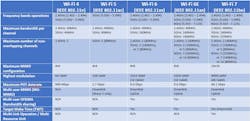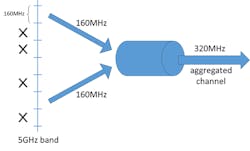What’s Powering Performance and Efficiency in the Latest Wi-Fi Standards?
This article is part of the TechXchange: IoT & Narrowband Communications
Members can download this article in PDF format.
What you’ll learn:
- How successive generations of Wi-Fi have enhanced performance.
- Why Wi-Fi 6E has achieved widespread market adoption, and what we can expect with Wi-Fi 7
- Use cases that will benefit the most from Wi-Fi 7.
Managed by the Wi-Fi Alliance since 1999, Wi-Fi (also known as WLAN or IEEE 802.11xx) has delivered the flexibility and convenience of wireless network connectivity at multi-megabit and, more recently, multi-gigabit data speeds.
Wi-Fi has proved to be a critical enabler for the services and freedoms many enjoy today, such as connecting to the internet easily and casually in any room at home, and in venues such as cafes and while traveling. Moreover, the ability to connect new devices without installing extra infrastructure is a key component for today’s digital homes, populated by smart appliances and served by streaming entertainments, online gaming, and much more.
With the smart/connected home and wearables market segments now expected to drive major growth, market analyst ABI predicts Wi-Fi device shipments will exceed 5 billion units in 2026.
As always, enablement sparks rising demand, with more devices per household and per user, simultaneous streaming to multiple rooms, and the explosion of IoT applications (including building automation) all potentially using Wi-Fi to connect to the internet.
In response, successive generations of Wi-Fi standards have enabled higher data rates and allowed a greater number of devices to connect to a given access point at any one time. The latest standards also add extra flexibility to support the needs of different types of connected devices.
Wi-Fi Evolution: MIMO and More
The table summarizes the performance and features of the most recent generations of the Wi-Fi standard.
Wi-Fi has used both the 2.4- and 5-GHz frequency bands since its second generation (IEEE 802.11a). Subsequent generations have benefited from extra channels with increased bandwidth in each frequency band. However, some of the most powerful improvements included the adoption of multiple-input/multiple-output (MIMO) antenna channels, as well as frequency sharing.
Single-user MIMO (SU-MIMO) arrived with the 4th generation (IEEE 802.11n) to enhance both performance and connection range. While basic MIMO involves coordinating all router antennas to communicate with one client device, SU-MIMO in Wi-Fi 4 allows each router antenna to be allocated separately to individual client devices.
Wi-Fi 5 (IEEE 802.11ac) then introduced multi-user MIMO (MU-MIMO), among other enhancements including 256-QAM modulation. MU-MIMO makes it possible to manage connections with several clients in parallel, each on different spatial streams. However, in Wi-Fi 5, this is limited to downlink communications from router to client only. Also, the maximum number of parallel client connections is limited, typically from two to four, depending on the router antenna configuration.
Wi-Fi 6 applies the advantages of MU-MIMO to both uplink and downlink connections. In addition, Wi-Fi 6 increases the maximum MIMO configuration from 4x4 to 8x8, doubles the maximum channel bandwidth, adopts QAM-1024 modulation, and employs a OFDMA LTE-like modulation multiplexing scheme.
The combined effect of these advances increases the maximum data rate more than fivefold over Wi-Fi 5. Network efficiency is increased, too, particularly in dense areas where more devices can be connected to the same access points. This ensures a better user experience with higher throughput and lower latency. It’s a major reason Wi-Fi 6 has achieved the fastest penetration rate ever for a new Wi-Fi generation.
MU-MIMO divides the MIMO operation of an access point (AP) between multiple users (or stations). Wi-Fi 6 allows for MIMO configurations of up to 8x8 antennas, which lets one AP handle up to eight 1x1 users simultaneously, one per spatial stream. The AP sends a single 8x8 MIMO packet over the air (downlink) containing data for each user on its respective allocated spatial stream. With MU-MIMO supported in the uplink as well, each user can reply simultaneously on its respective spatial stream.
Wi-Fi 6 also introduces multi-user OFDMA (MU-OFDMA). As a result, the total available bandwidth can be divided into resource units (RUs), making them available to multiple users so that more are able to connect to the AP. Up to 37 simultaneous users can share an 80-MHz channel, each using down to just 2 MHz of bandwidth. These narrowbands also enhance coexistence with other narrowband technologies in the same frequency range, such as Bluetooth, Thread, and Zigbee.
MU-MIMO and MU-OFDMA enable an AP to better schedule traffic among users, with proper granularity and better control on quality of service (QoS). Hundreds or even thousands of devices may be connected to the AP with limited congestion. Moreover, the slower Wi-Fi 6 IoT devices can seamlessly coexist with Wi-Fi 6 high-demand devices without impacting their throughput and latency.
In addition, Wi-Fi 6 introduces target wake time (TWT), which enables devices connected to the AP to go into deep sleep and wake at a scheduled time to share data. This helps maximize energy savings in power-conscious devices and reduces conflicts.
Moving Forward with Wi-Fi 6E
In addition to operating on the 2.4-GHz band, Wi-Fi standards from the second generation onward have used 5 GHz. As the 2.4-GHz band has become increasingly crowded with other technologies such as Bluetooth, Zigbee, and Thread, this higher band provides a means of avoiding congestion.
However, with continuously increasing demand for data bandwidth, pressure on the capacity of the 5-GHz channel has continued to grow. Video-streaming services are offering higher-resolution video, while the rollout of fiber-to-the-home delivers super-fast internet that then needs to be served out within the premises. The recent surge in working from home during the COVID-19 pandemic also increased the appetite for reliable, high-speed Wi-Fi.
Wi-Fi 6E addresses these pressures by adding the 6-GHz band (5.925 to 7.125 GHz) to further expand capacity. The extra 1.2 GHz of bandwidth provides seven extra channels of 160 MHz each. This contrasts with the 5-GHz band, which provides only two channels of such width. Alternatively, there are up to 14 channels of 80 MHz each whereas only five of these were available on the 5-GHz band.
CEVA has developed Wi-Fi IP solutions that include MAC and modems for Wi-Fi 4/5/6/6E generations, supporting station/client (STA) and AP modes in SISO and MIMO configurations for bandwidths up to 160 MHz.
Wi-Fi 6E has already achieved widespread market adoption. The forthcoming generation, Wi-Fi 7, now promises additional, exciting advantages.
More of Everything with Wi-Fi 7
Wi-Fi 7 is almost 5X faster than Wi-Fi 6/6E. In addition, two important new innovations allow for flexible use of the resources to increase throughput and reduce latency. One is multi-link operation (MLO), which allows aggregation of two channels from the same or different bands.
The 6-GHz bands provide three 320-MHz channels, although interference can prevent finding an entire channel to be available. With MLO, any combination of channels in the 5- and 6-GHz bands may be combined. This could be two disjointed 160-MHz channels from the seven available in the 6-GHz band, one channel on the 6-GHz band with another on the 5-GHz band, or two channels from the 5-GHz band (see figure).
Another possibility is aggregation of 160- and 80-MHz channels on the 5- and 6-GHz bands. In addition, MLO can be used for load balancing, quickly and seamlessly switching between channels to minimize contentions and retries, which also reduces latency.
A second new concept introduced by Wi-Fi 7 is the multi-resource unit (MRU). It allows aggregating two RUs to satisfy a large throughput requirement for a single user. Such a large bandwidth may not be free throughout the whole channel bandwidth, so MRU aggregates RUs on the same channel.
The principle is similar to that behind MLO, and the aggregated units can be contiguous or disjointed. We expect Wi-Fi 7 solution providers to differ in terms of how, when, and which channels to aggregate.
With these two powerful innovations, Wi-Fi 7 performs particularly well where high throughput, low latency, and high link reliability are required. Examples include gaming, connectivity for AR/VR headsets, and video distribution. Moreover, Wi-Fi 7 will significantly improve experiences in dense environments such as airports and offices, where users are moving and frequently switch dynamically between emailing, browsing, chat, file transfers, and video conferencing.
Conclusion
With continuous evolution, to meet user expectations and facilitate emerging use cases, Wi-Fi has remained enduringly popular and effective. With extra channels and frequency bands, SU- and MU-MIMO, and techniques for efficient resource sharing, the maximum data rate has increased from a 600 Mb/s in the fourth generation to 9.6 Gb/s in Wi-Fi 6E.
Progress continues to accelerate and users accessing the internet through Wi-Fi 7 can look forward to significantly faster data speeds, greater flexibility and reliability, and lower latency.
Read more articles in the TechXchange: IoT & Narrowband Communications
About the Author
Franz Dugand
Senior Director of Sales & Marketing, Wireless IoT Business Unit, CEVA
Franz Dugand is the Senior Director of Sales & Marketing, Wireless IoT Business Unit at CEVA. Dugand oversees the expansion of CEVA’s Bluetooth, Wi-Fi, UWB, and NB-IoT product lines into various market segments such as mobile, consumer electronics, gateway, healthcare, automotive, industrial, and other IoT applications.


